by Hoài Nam
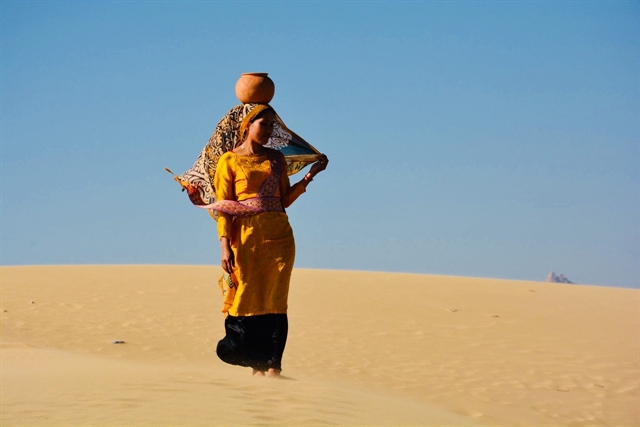
Kiều Maily, a Chăm artist, features traditional costumes in an outdoor performance on sand dunes in Ninh Thuận Province. Photo courtesy of Kiều Maily
Born and raised in a Chăm ethnic community in the hot and sandy Phước Nhơn Village, 10km from Phan Rang City, Ninh Thuận Province, Kiều Maily made a life in HCM City as a broadcaster and writer, but ancient Hội An City became a favourite destination for her to promote the traditional culture of Chăm people.
Maily, 36, travelled to Hội An in late 2018 to begin her journey in introducing herbal therapy – one of three key trades of the Chăm, including Mỹ Nghiệp brocade weaving and Bàu Trúc terracotta – in Ninh Thuận.
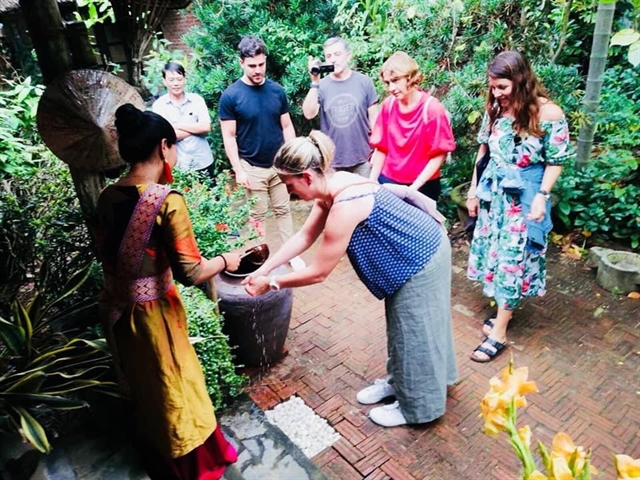
Hosting visitors by cleaning their hands from a water jar is a traditional gesture of the Chăm people. Photo courtesy of Kiều Maily
Almost all the villagers in Phước Nhơn Village who are part of the Chăm Bani, a religious community in Ninh Thuận, leave their homeland for herbal medicine practices nationwide, even crossing the border for two to seven months per year. They generally only return home for the traditional Ramuwan festival, the biggest festival for the Chăm in Việt Nam.
The home-grown herbs are concocted and developed in traditional families, so at least 80 per cent of villagers in Phước Nhơn and An Nhơn learn herbal medicine from their ancestors.
Maily grew up surrounded by the arts and traditional culture of the Chăm and almost all Chăm women learn folk dances in kindergarten.
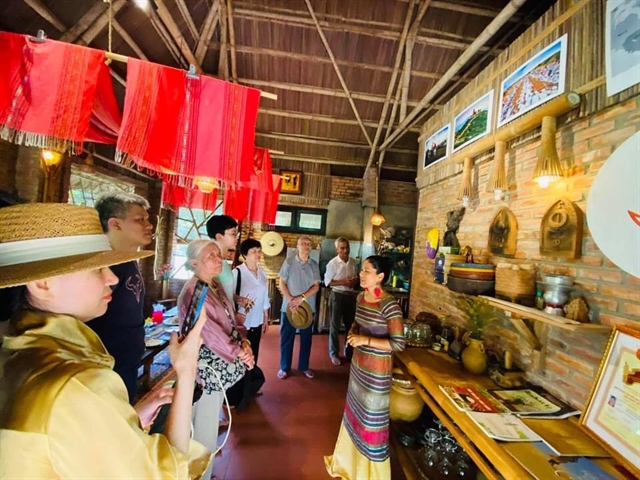
Tourists enjoy exploring the Champa Amaravati House Hội An -- a Chăm experience centre -- in the tourism hub of Hội An. Photo courtesy of Kiều Maily
"I learnt dances in traditional music from five years old. Chăm dances would transmit from mothers to their baby girls, and then girls grow up with dance skills learnt from their mothers," Maily says.
"Traditional dances have been with me since childhood. I could play the "paranung" drum, a rare Chăm woman able to. But I'm not allowed to play at ritual festivals because it is reserved for men only as a rule."
The Chăm artisan says she cooks ethnic cuisine as a nutritional therapy that has been branded for the community in Phước Nhơn Village.
Maily began a life in HCM City by broadcasting in the Chăm language on Radio the Voice of Việt Nam (VOV) and writing books and poems while promoting Chăm culture.
However, she eventually recognised that Chăm culture needed an art space to make it well-known among tourists and people worldwide, and set up a cultural house in Hội An.
"It's the reason I decided to leave HCM City in late 2017 to begin the Chăm culture introduction in Hội An – an international tourism hub – where millions of visitors from over the world come to experience the mixed culture and architectural preservation of a 400-year-old busy trading port," she says.
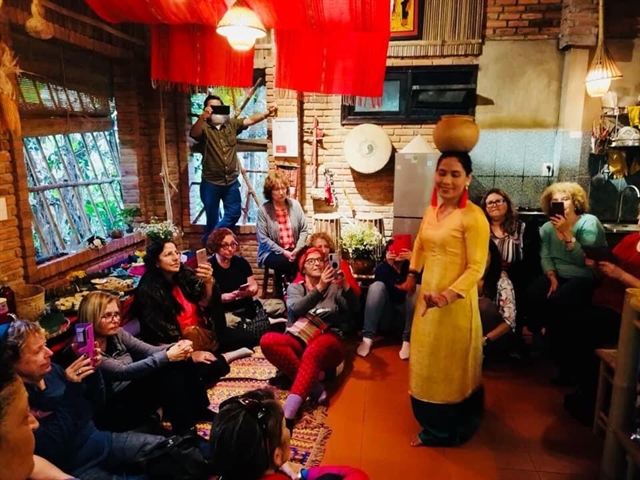
Dancing with a water jar on the head is one of the regular daily art performances of the Chăm people. Visitors can explore Chăm culture when they come to Chăm space in Hội An. Photo courtesy of Kiều Maily
She opened the Champa Amaravati House Hội An (Amaravati was a small state of current-day Quảng Nam and Đà Nẵng of the Champa Kingdom in 657-1471), a Chăm art, history and cuisine space in a tranquil suburban area near the Cẩm Thanh nipa palm forest in Hội An.
"Hội An still preserves the arts, lifestyle and culture of the Champa Kingdom, which has blended with different cultures and architecture of the Great Việt, Japanese and Chinese over previous centuries," she says.
She officially debuted the Champa Amaravati House Hội An tours as an art, exhibition and cuisine experience space in 2020.
"The Champa Amaravati House is the only site in Hội An reviving Chăm culture that was rooted in Hội An and central Việt Nam a long time ago. Before, tourists could only see Champa culture through exhibits at Đà Nẵng-based Chăm sculpture museum and tower ruins in Mỹ Sơn Sanctuary in Quảng Nam, or the terracotta trade in Hội An," she says.
"The Champa Amaravati House offers visitors lively performances and Chăm cuisine. Tourists enjoy the true art of Champa culture while sharing the historical stories of exhibits and art performances told by Chăm artists."

Curry is one of the significant food of the Chăm. It shows the use of medicinal herbs in cuisine among the Chăm community. Photo courtesy of Maily
Maily says she hosts tourists with paranưng drum playing and dances in Chăm costume, cooking demonstrations and experiences with tea, cakes and stories of family tools and instruments as well as the history of song and dance in Chăm tradition.
She does everything to serve tourists in her art space, from preparing food and making tea to art performances and reciting ancient stories.
"Tourists can find a typical Chăm's living space at my cosy house with activities and different aspects of traditional culture through my descriptions of food, dances and drumming," she says.
"It also provides a Chăm culture tour of archaeological objects in the museum and architectural ruins and is a multicultural experience exchange site."
She also sings old folk songs in the Chăm language that her native people used to play at ritual festivals. These songs highlight the beauty of the Chăm people and land, lifestyles and love duets sung by the men and women.
Native village
Phước Nhơn Village in Xuân Hải Commune – a suburban area of Phan Rang – is where 85 per cent of the Chăm population make a living from herbal medicine passed down from many generations.
Chăm Bani villagers are famous for making remedies from garden-grown plants. However, herbal physicians from Phước Nhơn travel with remedies to offer treatments nationwide.
"The Chăm people in Phước Nhơn use herbs collected in the forest for the treatment of stomachaches, joint pains, colds, nerve pains, or hypertension," Maily says.
"They use main materials including citronella, ginger, turmeric and spicy leaves such as pepper mint as ingredients for daily cooking to protect against illness."
The artisan says she wants to make her birth village an eco-tour site in the south-central coastal region, highlighting ancient culture preservation, the medicinal herb trade and the lifestyle of the Chăm.
She hopes the Champa Amaravati House will help build tour links on Chăm culture in destinations from Thừa Thiên Huế to Bình Thuận and southern provinces.
Curry with goat, fish and chicken is a favourite food of the Chăm, which Maily often cooks for visitors at the house.
Popular Chăm dishes such as muthin ritong (rice served with fish), lithei jrau (rice mixed with meat and vegetables), abu mutham (gruel served with fish and traditional vegetables), and kari cam murong (chicken or beef curry) are the most popular on the menu, she says.
Maily has also introduced a book on the culinary techniques of the Chăm – Unique Chăm Cuisine – which includes 96 dishes mostly cooked with medicinal herbs.
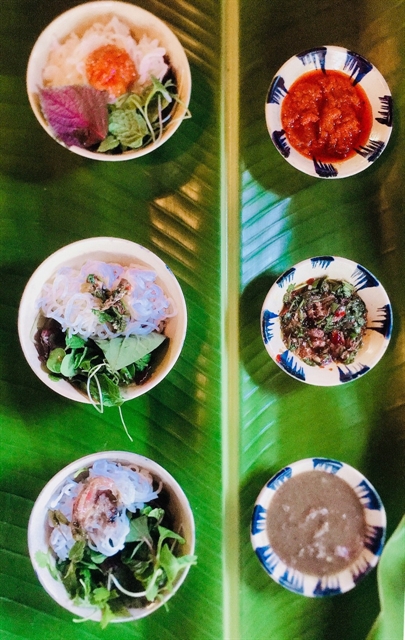
The cooking style of the Chăm offers healthy ingredients from medicinal herbs in every dish. Photo courtesy of Kiều Maily
"Food not only provides nutrition and energy but keeps families healthy with ingredients from garden herbs. Chăm people often offer medicinal herbal cuisine and drink to ease seasonal colds, headaches, joint aches and tiredness. Spicy herbs and roots can be easily found in gardens or the jungle," she says.
"It is why I included cooking culinary techniques and stories of the healthy function of herbs that have remained the major non-drug treatment for the community for centuries."
Maily says the outbreak of COVID-19 disrupted the operation of Amaravati House for several months but expects tourism to fully resume in Hội An this year.
She has begun decorating the unique Chăm cultural space after months of COVID lockdown, so that visitors can experience the unique culture as part of Hội An's recovery plan. — VNS
OVietnam